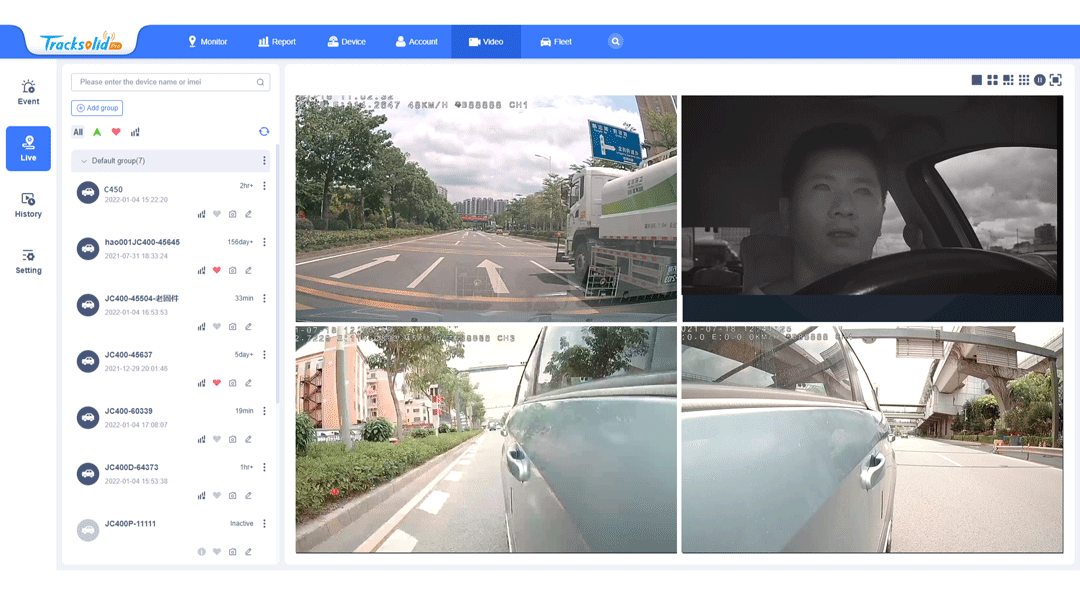Introduction
Modern road systems worldwide present unique challenges for drivers, including crowded urban streets, unpredictable rural highways, and diverse weather conditions. In 2023, the global increase in road accidents[^1] underscored the urgent need for advanced safety solutions. Advanced Driver-Assistance Systems (ADAS)[^2] have emerged as a transformative technology, helping to reduce human errors—the leading cause of accidents—and redefining road safety and fleet management practices[^3]. By enhancing both safety and efficiency, ADAS is making roads safer and fleet operations more effective globally.
The Growing Importance of ADAS in Fleet and Road Safety
TThe global ADAS market[^4] has been expanding rapidly, driven by government safety regulations[^5] and growing demand for safer vehicles. Estimated at billions of dollars, this market is expected to see sustained growth over the coming years. The adoption of ADAS is fueled by its ability to address complex driving challenges, from urban congestion to lengthy rural routes. These systems support drivers by automating critical tasks, such as maintaining lane discipline, braking to avoid collisions, and adjusting speed based on traffic conditions.
ADAS reduces the driver’s workload, enabling quicker responses to potential hazards. This not only helps prevent accidents but also minimizes driver fatigue[^6]—one of the primary contributors to road mishaps in long-haul and high-pressure environments.

Revolutionizing Road Safety: Key Features of ADAS
ADAS combines advanced sensors, cameras, and software algorithms to monitor surroundings and assist drivers in real-time. Below are some of the core features transforming road safety:
- Adaptive Cruise Control (ACC):
ACC adjusts the vehicle’s speed to maintain a safe distance from other vehicles. It’s particularly beneficial on highways and long routes, reducing driver fatigue by automating repetitive speed adjustments. - Lane-Keeping Assist (LKA):
This feature helps vehicles stay within their lane, reducing risks caused by drifting due to distraction or fatigue. It is especially valuable for long-distance drivers and fleets operating under tight schedules. - Automatic Emergency Braking (AEB):
By detecting imminent collisions, AEB applies the brakes automatically to avoid or mitigate impact. This feature is crucial for both urban traffic and rural roads where unexpected obstacles, such as animals, can appear suddenly. - Blind Spot Detection:
This system alerts drivers to vehicles or objects in their blind spots, making lane changes safer and reducing side-impact collisions. - Traffic Sign Recognition (TSR):
TSR identifies road signs, such as speed limits or warnings, and alerts the driver, ensuring compliance with traffic laws and improving overall situational awareness.
The Role of ADAS in Fleet Management
Integrating ADAS into fleet operations provides powerful tools for improving safety, efficiency, and cost-effectiveness. When combined with fleet management platforms, ADAS delivers real-time insights into driver behavior, vehicle performance, and potential safety issues.
- Improved Driver Behavior:
ADAS-enabled systems detect risky behaviors, such as speeding or harsh braking, and provide instant feedback to drivers. Fleet managers can analyze this data to implement targeted training programs, reducing accident rates and promoting a culture of safety. - Lower Operating Costs:
By preventing accidents and enhancing fuel efficiency through features like adaptive cruise control, ADAS helps fleets reduce costs related to insurance, vehicle repairs, and fuel consumption. - Real-Time Alerts and Analytics:
Advanced platforms integrate ADAS data with GPS tracking, enabling managers to respond to incidents immediately and optimize routes for efficiency.

In industries such as logistics, agriculture, and construction, ADAS enhances safety in high-risk environments, such as worksites or hazardous terrain. Features like AEB and blind spot detection play a vital role in reducing workplace accidents and ensuring compliance with safety standards.
Meeting Global Challenges with ADAS
The diverse conditions drivers face worldwide—ranging from congested urban areas to isolated rural roads—demand adaptable safety solutions. ADAS rises to the challenge by providing context-sensitive assistance tailored to specific environments:
- Urban Environments:
In busy cities, traffic sign recognition[^7] and automatic braking help drivers navigate complex traffic patterns and prevent rear-end collisions. These features are invaluable for fleets operating in delivery and ride-sharing sectors, where frequent stops and tight schedules are common. - Rural and Remote Areas:
On long, open roads, features like lane-keeping assist[^8] and adaptive cruise control support drivers by reducing the risk of fatigue-related accidents. ADAS also helps drivers maintain focus and handle unexpected obstacles, such as wildlife or sudden weather changes.
The Future of ADAS in Fleet Operations
As global road networks modernize and governments tighten safety regulations, the adoption of ADAS is set to accelerate. These systems align with broader goals of reducing road fatalities and achieving sustainable transportation. By improving fuel efficiency and reducing emissions through optimized driving patterns, ADAS also contributes to environmental sustainability.

Fleet operators that embrace ADAS now stand to gain significant advantages, including:
- Enhanced Safety Compliance: ADAS helps fleets meet stringent safety standards, ensuring drivers and vehicles operate within legal frameworks.
- Cost Savings: Fewer accidents and optimized fuel consumption translate to lower operating expenses over time.
- Increased Operational Efficiency: Real-time data from ADAS systems enables better decision-making, improving route planning and asset utilization.
As ADAS technology continues to advance, integrating features like AI-powered decision-making and predictive analytics, its role in global fleet management will become even more transformative. By adopting ADAS, fleets can future-proof their operations, ensuring safer roads and smarter logistics for years to come.
Conclusion
Advanced Driver-Assistance Systems are revolutionizing how safety and efficiency are managed on roads and in fleets. By minimizing human error and providing intelligent, real-time support to drivers, ADAS creates a safer and more sustainable transportation ecosystem. Whether navigating urban streets or traversing challenging rural highways, the integration of ADAS offers a path to improved safety, operational excellence, and long-term cost savings.
For fleet operators, the future is clear: investing in ADAS is not just a step forward—it’s the road to a smarter, safer tomorrow.
[^1]: Understanding the main causes of road accidents can help in identifying effective prevention strategies and safety measures.
[^2]: Exploring the benefits of ADAS can provide insights into how technology is reducing road accidents and enhancing safety.
[^3]: Discover how ADAS is revolutionizing fleet management by improving safety and operational efficiency.
[^4]: Understanding the ADAS market’s size and growth forecast can provide insights into industry trends and investment opportunities.
[^5]: Exploring the impact of government safety regulations on the ADAS market can reveal how policy shapes industry growth and innovation.
[^6]: Learning about how ADAS technology reduces driver fatigue can highlight its benefits for road safety and driver well-being.
[^7]: Explore how traffic sign recognition technology enhances safety and efficiency in navigating complex urban traffic, crucial for fleet operations.
[^8]: Discover the advantages of lane-keeping assist for drivers on long, rural roads, including reduced fatigue and increased safety against unexpected obstacles.
Why JimiIoT
JimiIoT is a global leader in innovative IoT solutions. We provide cutting-edge hardware and software tailored to enhance efficiency and connectivity. Our range of products includes advanced GPS tracking devices, asset management solutions, smart vehicle dashcams, and telematics platforms. With a focus on technological excellence and customer satisfaction, we empower businesses to optimize operations and gain valuable insights from data-driven analytics. Trust JimiIoT to drive positive change and unlock growth opportunities in the digital age.
If you would like more details, please visit Facebook, LinkedIn, INS, and Twitter pages for further information.
 US
US ES
ES PT
PT TH
TH VN
VN JP
JP



